 Technology peripherals
Technology peripherals
 AI
AI
 AI blows up physics! Is 21-degree room temperature superconductivity scheduled for the Nobel Prize? Professor Nature withdraws his manuscript but receives investment from OpenAI
AI blows up physics! Is 21-degree room temperature superconductivity scheduled for the Nobel Prize? Professor Nature withdraws his manuscript but receives investment from OpenAI
AI blows up physics! Is 21-degree room temperature superconductivity scheduled for the Nobel Prize? Professor Nature withdraws his manuscript but receives investment from OpenAI
Have humans achieved room temperature superconductivity at 21°C?
The physics circle completely exploded! Yesterday afternoon, Beijing time, a thunder exploded at the physics conference held in Las Vegas, USA - high-temperature superconductivity was suspected of achieving a disruptive breakthrough.
At the meeting, Ranga Dias, a physicist at the University of Rochester, reported this landmark breakthrough in room temperature superconductivity research.
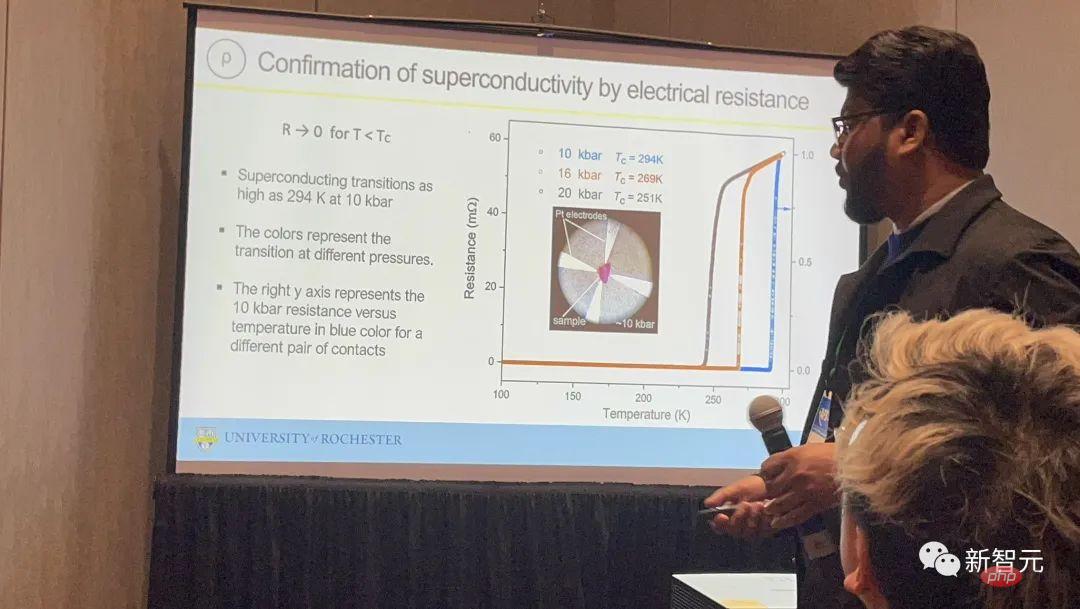
##If Ranga Dias really achieves room temperature superconductivity this time, then the global energy consumption problem will start from the source Solution - Human beings will use electrical energy to gain tremendous power.
If we can master controllable nuclear fusion from the ground up, we can even conduct long-distance space travel. It can be said that mankind will really take off.
And those who master this technology will undoubtedly lead the world. (It’s like science fiction coming into reality.)
In this regard, James Hamlin, a physicist at the University of Florida, said that if the results are correct, this may be the largest and most successful superconducting event in the history of superconducting. Shocking breakthrough.
On that day, scientists rushed into the venue crazily, hoping to witness history with their own eyes. Due to the high content of physics celebrities, the organizers had to call in security to block the door and drive away the crowd.
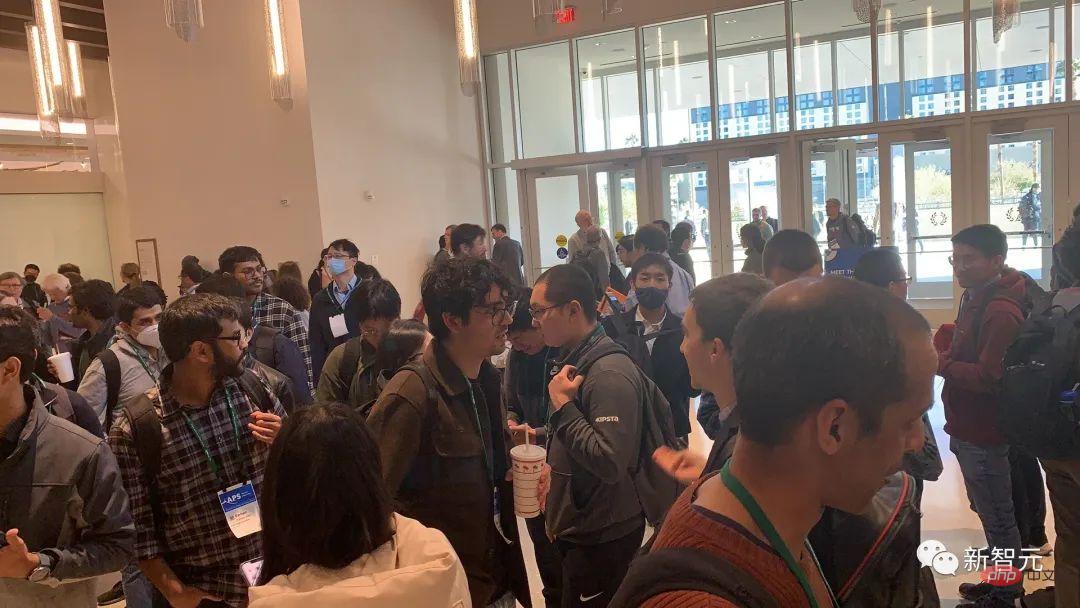
However, this Ranga Dias has a "black history". A year ago, his article on C-S-H room temperature superconductivity published in Nature was retracted, and now he is making a comeback with N-Lu-H room temperature superconductivity.
So, until the experimental results can be successfully reproduced, the whole thing is still full of doubts.
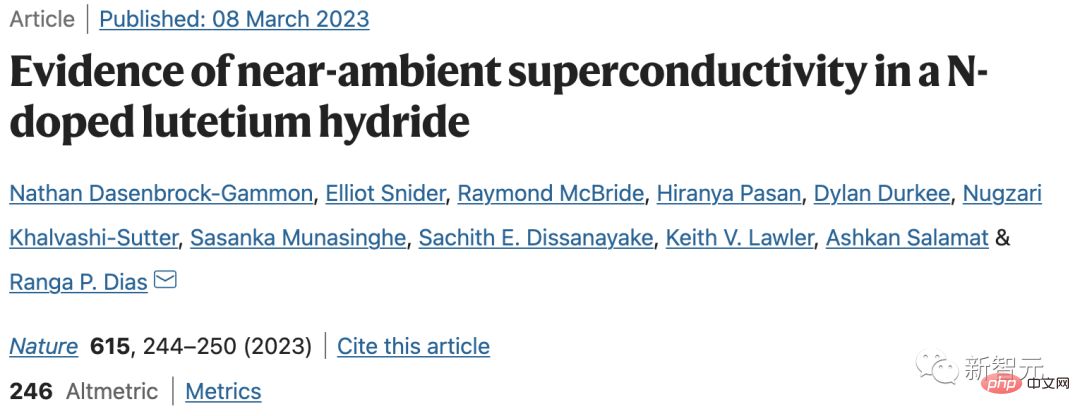
Paper address: https://www.nature.com/articles/s41586-023-05742 -0
Go to Nature again, will room temperature superconductivity reach its finale?Why is room temperature superconductivity so important that it shocks physicists around the world?
Superconductor, as the name suggests, is a body that can conduct electricity super well, that is, it has zero resistance. This allows the current to be transferred without generating heat, and no voltage is required at either end of the wire.
If superconductors can be commercialized, alternating current will not be needed at all, and substations can also withdraw from the stage of history.
The current passing through a superconductor is very large, which can produce a strong magnetic field. It has great applications in nuclear magnetic resonance, magnetic levitation and other fields. It does not even require controllable nuclear fusion. Liquid nitrogen is superconducting.
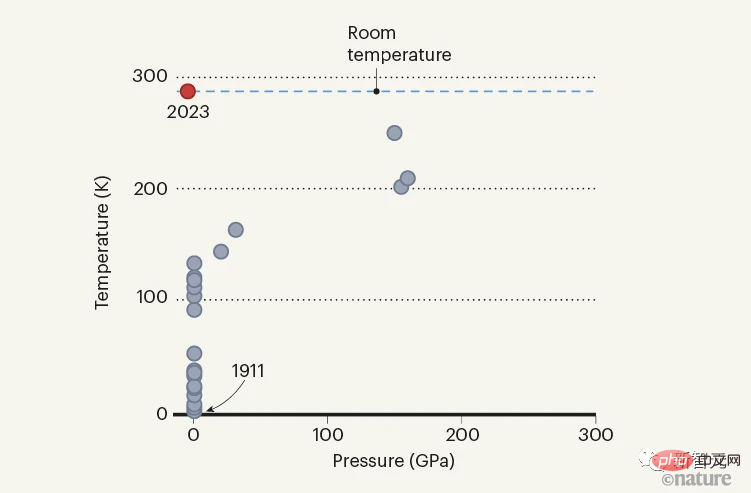
If it is really realized, the world of physics and materials science will usher in a big earthquake. (From ChatGPT at the end of last year to room temperature superconductivity at the beginning of this year, has the explosive year of human technology really come?)
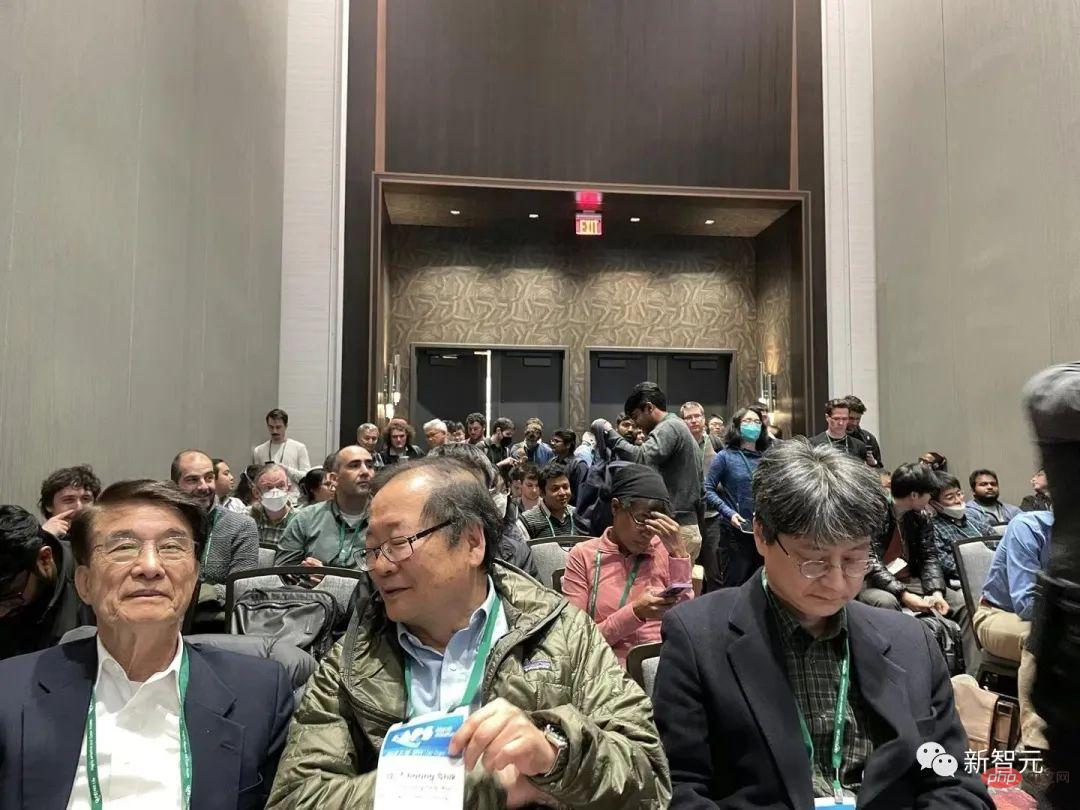
##Professor Zhu Jingwu, the leading figure in high-temperature superconductivity, also appeared at the venue
What is superconductivity? K. Onnes and others from Leiden University in the Netherlands first discovered in 1911 that the resistance of mercury will become 0 when the temperature is cooled below -269°C. They named this state "superconductivity." This was the world's first discovery of superconductivity, for which Onnes won the 1913 Nobel Prize in Physics. In the following more than a hundred years of research, scientists discovered thousands of superconducting materials, including various elemental materials, alloy materials, compound materials and superconducting ceramics . Although current superconducting materials have been widely used in fields such as quantum and MRI, they must be cooled to ultra-low temperatures to achieve superconducting states. In other words, in practical applications, we still need to rely on expensive cryogenic liquids to maintain a low-temperature environment. It follows that the cost of maintaining low temperatures far exceeds the cost of the superconducting material. Therefore, room temperature superconductivity, achieving zero resistance conduction without cooling, has become the goal pursued by physicists, constantly refreshing the limit of the highest critical temperature. 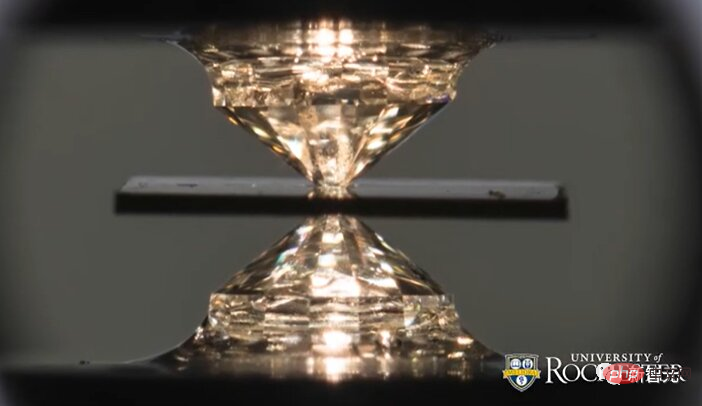
In this latest research, Ranga Dias and his team developed a hydrogen-based (99%), nitrogen (1%) and pure lutetium material LNH.
Scientists placed this material in an environment of 392k to react for 3 days. The ternary compound consisting of hydrogen, nitrogen and lutetium starts out as a lustrous blue color.
This compound was compressed in the diamond anvil tank. When the pressure reached 3kbar, an amazing change occurred "the superconductivity began to change from blue to pink."
Finally, it turned bright red again at about 30kbar pressure and the resistance dropped to zero.
Ranga Dias gave the shocking discovery the codename "reddmatter." The name was inspired by the name of a material created by Spock in Star Trek.

Experiments found that the material lost any resistance to current at a temperature of about 21 degrees Celsius and a pressure of 1 GPa resistance and enters the superconducting state.
1GPa is about 10,000 times the atmospheric pressure (standard atmospheric pressure is about 101.325kPa), but compared to the millions of atmospheres required for room temperature superconductors, this is far lower than expected.

So how to prove that this ternary compound reaches the conditions of superconducting?
The paper mentioned that a key criterion for judging superconducting materials is the Meissner effect, which is complete diamagnetism.
Complete diamagnetism can be achieved because the surface of the superconductor can generate a lossless diamagnetic superconducting current. The magnetic field generated by this current cancels the magnetic field inside the superconductor.
The temperature dependence of the magnetic moment and M-H curve at different temperatures was measured using the vibrating sample magnetometer (VSM) method on the Quantum Design Physical Properties Measurement System (PPMS).
Figure 3a shows the effect of temperature on DC magnetic susceptibility under zero field cooling (ZFC) and field cooling (FC) conditions. (χ = M/H, where M is the magnetization and H is the magnetic field)
The existence of the superconducting phase was then confirmed by measuring the Meissner effect of cooling in a magnetic field. The clear onset of the Meissner effect is observed at 277K around 8 kbar. M-H curve data were recorded using PPMS with VSM option.
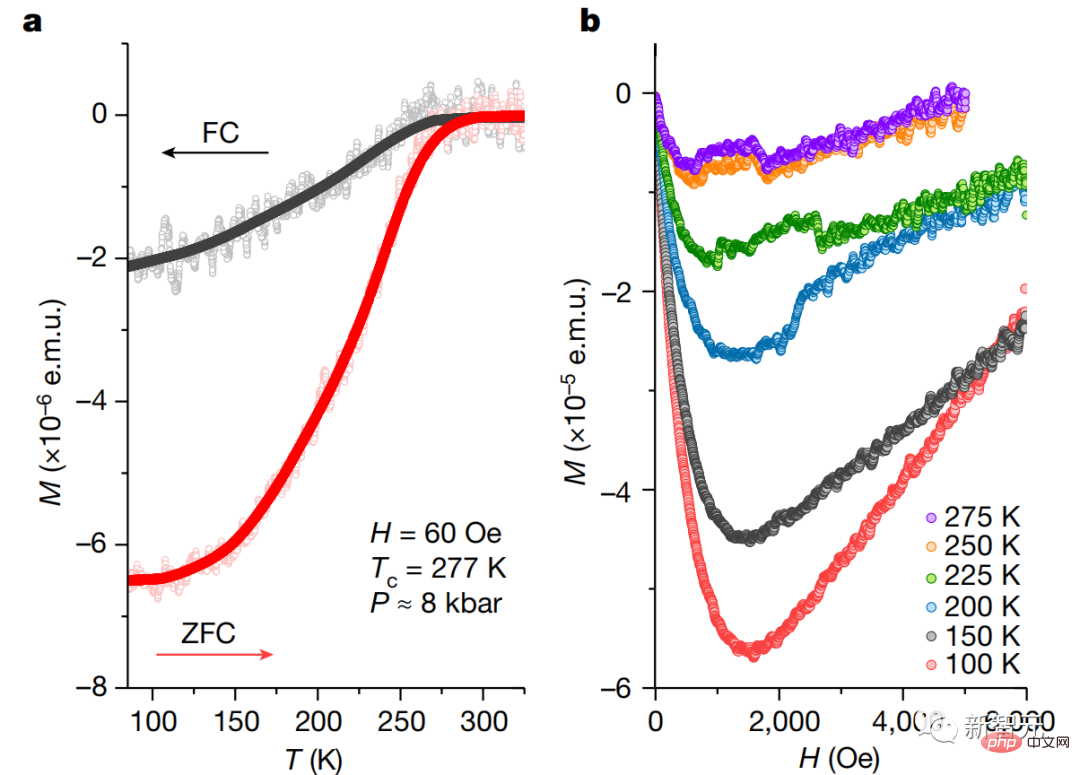
Magnetic susceptibility
Another criterion is the zero resistance effect.
refers to the phenomenon that it is a conductor, semiconductor, or even an insulator at room temperature, but when the temperature drops to a certain value Tc, its DC resistance suddenly drops to zero. .
In the experiment, the temperature-dependent resistance of the hydrogen-nitrogen-lutetium compound at high pressure showed a superconducting transition up to 294K at 10±0.1 kbar, which was measured in all experiments maximum transition temperature.
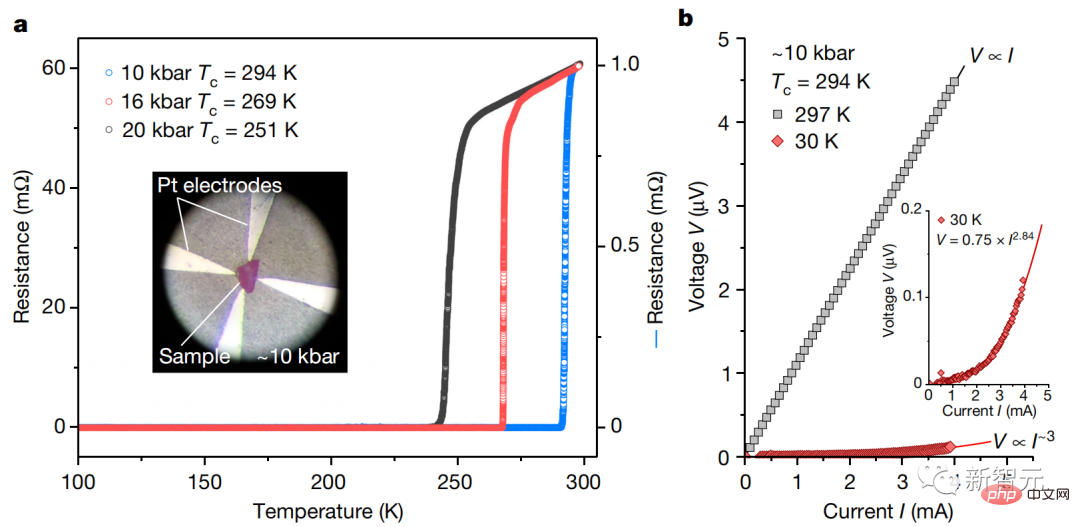
Nature said that if the hydrogen-nitrogen-lutetium ternary compound does achieve room temperature superconductivity, then it will The role in achieving such high transition temperatures remains to be determined.
Further research is needed to confirm that the material studied by Ranga Dias and his team is a high-temperature superconductor before it can be understood that this state is caused by vibration-induced Cooper pairs Cooper pairs), or driven by an unconventional mechanism that has not yet been discovered.
Machine learning algorithm for predicting new materials
It is worth noting that this experiment is predicting new superconductivity When collecting materials, machine learning algorithms are also used.
Using the superconducting experimental data accumulated in the laboratory, the team trained an algorithm to predict other possible superconducting materials.
These materials are actually mixed and matched from thousands of possible combinations of rare earth metals, nitrogen, hydrogen and carbon.
"In everyday life, different metals are used for different applications, so we also need different kinds of superconducting materials," Dias said. "Just like we use different metals for different applications, we need more environmental superconductors to meet different applications."
It is said that the algorithm was developed by co-author Keith Lawlor Developed using supercomputing resources provided by the University of Rochester's Integrated Research Computing Center.
Specifically, the approximate steps are that physicists use the Eliashberg spectral function, which is relatively easy to calculate, to train the neural network. After training, the neural network is used to generate more comparisons. The difficult-to-calculate Eliashberg spectral functions of ternary hydrides. Then you can calculate the Tc of various ternary hydrides, and then just try a few ternary hydrides with the highest Tc.
#Some netizens concluded: "Now we know that the hero behind today's big news is ML/AI."
The academic community expressed doubts that the author did not want to make it public
And even this experiment was not rigorous. It is said that a big boss raised questions at the meeting and confronted Dias on the spot.
Eagle-eyed netizens pointed out that the practice of cutting out the background in PPT (left picture) and the DC magnetic susceptibility data (right picture) are both suspected to be problematic.
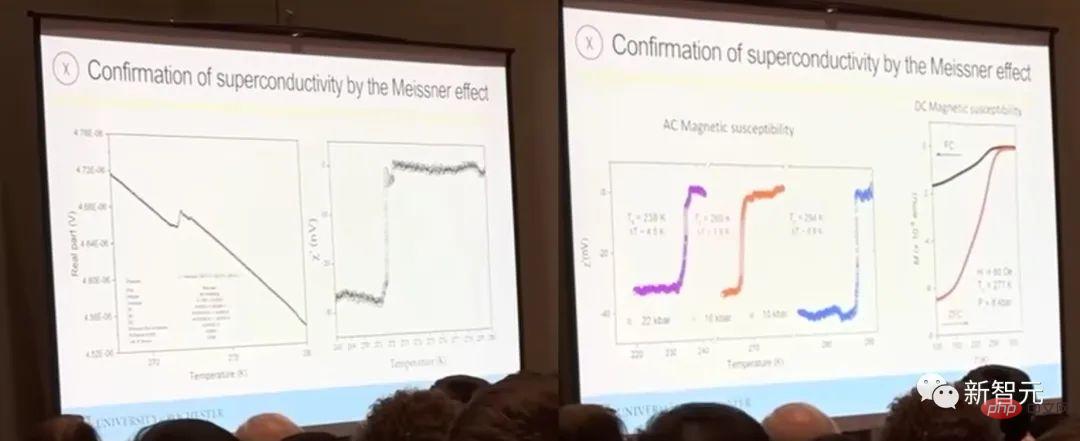

#From a netizen at Station B「 sddtc888》
Similarly, Nature and Science also expressed doubts in press releases.
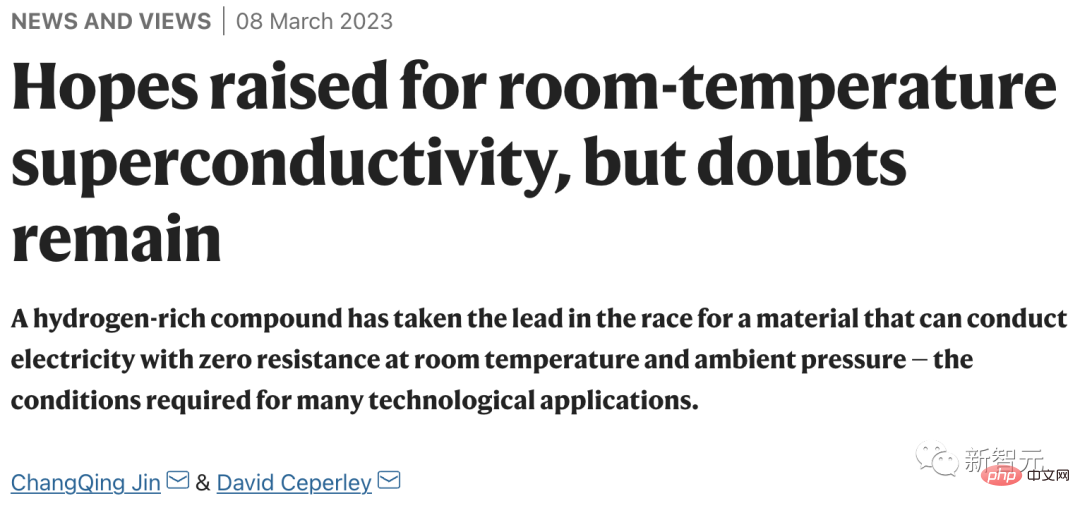
## Article address: https://www.nature.com/articles/d41586-023-00599-9

Article address: https://www.science.org/content/article/revolutionary-blue- crystal-resurrects-hope-room-temperature-superconductivity
#I think they have to really make their work public, everyone Only then can you believe it."
Jorge Hirsch, a physicist at the University of California, San Diego, even bluntly said: "I strongly doubt this because I do not believe these authors."
However, this wish of the academic community is about to come true-
Dias not only established a start-up company Unearthly Materials, but also applied for Patent on lutetium hydride.
With this wave of operations, he not only raised more than 20 million US dollars in funding from investors including Spotify and OpenAI, but he also did not have to worry about others coming to ask for " sample".
In this regard, Dias said: "We have clear and detailed instructions on how to make the samples. Considering the proprietary nature of the process and the existence of intellectual property rights, we do not intend to share this Materials, of course, including the methods and processes involved."
Epoch-breaking significance to mankindFor more than a century, scientists have been pursuing condensed matter physics. breakthrough.
Superconducting materials rely on two key properties: "zero resistance phenomenon" and "Meissner effect" (complete diamagnetism), which have greatly promoted the progress of science and technology. Use, for example:
- Controllable nuclear fusion
Tokamak is a ring-shaped vessel that uses magnetic confinement to achieve controlled nuclear fusion. In the center is a ring-shaped vacuum chamber with coils wrapped around it. When electricity is energized, a huge spiral magnetic field is generated inside the tokamak, which heats the plasma in it to a very high temperature to achieve nuclear fusion.
The application of superconducting technology on coils that generate strong magnetic fields can enable continuous and stable operation of magnetic confinement configurations, which is a recognized method for exploring and solving future fusion reactor engineering and physics the most effective way to solve the problem.
- Power transmission
When the power grid transmits power, it will not be affected as it is now. Up to 200 million megawatt hours (MWh) of energy are lost due to resistance in wires.
According to statistics, when copper or aluminum conductors are used to transmit electricity, about 15% of the electric energy is lost on the transmission line. In China alone, the annual power loss reaches more than 100 billion kWh. If we switch to superconducting power transmission, the energy saved will be equivalent to building dozens of large power plants.
- Transportation
Maglev high-speed train.
However, this magnetic levitation technology can be used not only in the transportation field, but also in the construction field. Maybe in the future it will no longer be a dream for humans to live in the air.
- Medical Imaging
MRI no longer needs to use a large amount of circulating water cooling to maintain its operation, so the operating cost will become lower and the magnetic field strength will be better.
Faster, more efficient electronic devices for digital logic and memory device technology. Imagine that your computer has no resistors, no longer needs heat dissipation, and the computer can be thinner and lighter. Moreover, using integrated circuits using superconducting transistors, the speed of computers can be directly increased by dozens or hundreds of times. The efficiency of electricity consumption will be higher, the electricity consumption at home will plummet, the light bulbs will be brighter, electric cars will run faster, and the use of electrical appliances will become more convenient. More fine electrical components can be used in our lives. 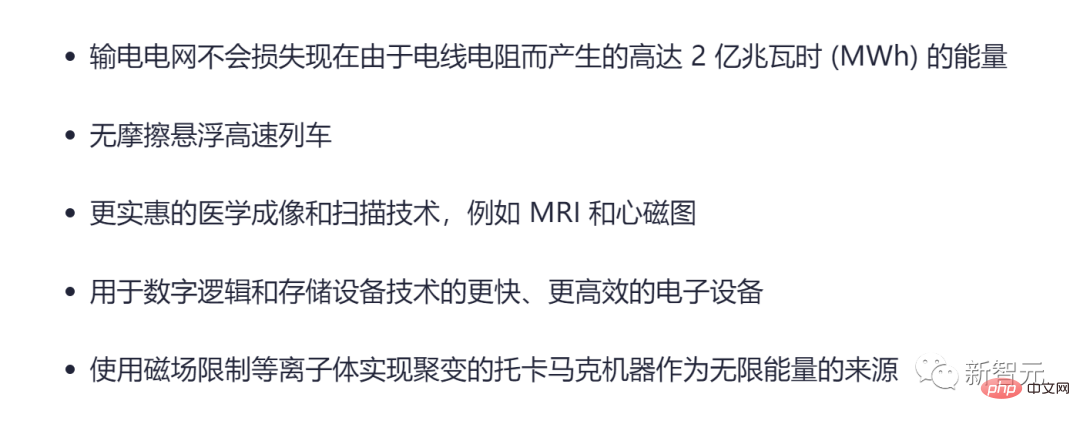
Source: phys.org
- Quantum Computing
In 2013, two famous quantum computing experts, Yale University professors Devoret and Schoelkopf, wrote an outlook, giving A roadmap for the development of universal quantum computing has been drawn up, and today’s superconducting quantum computing is already in the third to fourth stages of development.
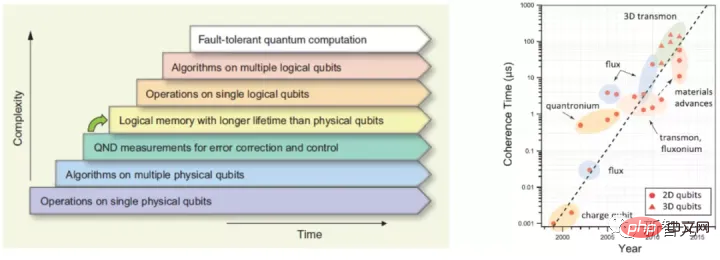
The MIT research team showed the "Moore's Law" of the decoherence time of superconducting qubits, starting from the earliest Qubits lasted less than 3 nanoseconds, rising to the current level of 300 microseconds. In less than twenty years, it has improved by five orders of magnitude, which shows the rapid development of this field.
Moreover, several well-known technology companies, including Google, IBM, Intel, etc., have participated in the research and development of quantum computing, and they have all chosen superconducting solutions.
If room temperature superconductivity is feasible, applications on quantum computers, including quantum simulation, optimization, sampling, quantum artificial intelligence, etc., will surely begin to change our world in the near future. production and lifestyle.
There is a lot of dark history, the previous study has just been retracted
As soon as this incident came out, there was a lot of doubts. This is also because everyone in the circle knows , Dias is an "old" academic star with a heavy criminal record.
In 2014, the metallic hydrogen he developed was highly praised. However, when people wanted to check the experimental results, Dias claimed that the diamond used to preserve the metallic hydrogen was broken. Therefore, there is no evidence of death.
In the field of room temperature superconductivity, Dias made big news two years ago.
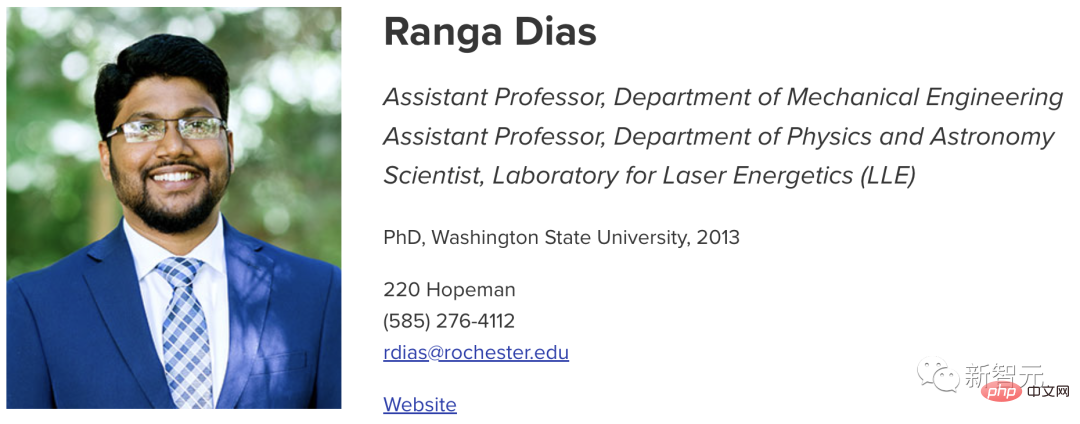
##On October 14, 2020, the Dias team published an article in Nature and appeared on the cover, claiming that a carbon The new material composed of , sulfur and hydrogen can achieve room temperature superconductivity, which caused a global sensation.
However, after the paper was published, controversy continued. Even Dias's lab partners were unable to replicate his experimental results (they failed six times).
Various controversies mainly revolve around the measurement data of magnetic susceptibility in the article-the curve after noise processing is too smooth and perfect, while the Dias team reported that after removing the noise, the original curve was measured data, but this data has not been released.
In response to doubts, Dias et al. released the original magnetic susceptibility data on arXiv in 2021 and explained their method of eliminating noise signals.

However, critics still don’t buy it. Brad Ramshaw, a quantum materials physicist at Cornell University, believes that “this article exposes more new problems than it attempts to solve, regardless of the raw data. The process of obtaining the data is very opaque."
Jorge Hirsch, a theoretical physicist at the University of California, San Diego, even fiercely accused Dias of fraud. He not only published critical remarks on arXiv, but Complaints were also made directly to the University of Rochester.
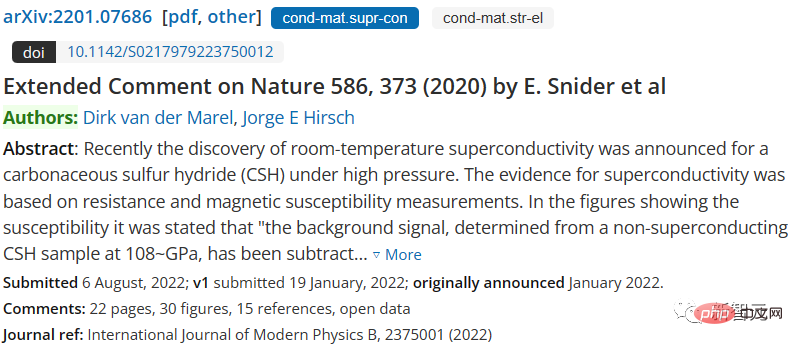
This is also reasonable to be reasonable to be referenced by 35,000, HIRSCH's questioning. He saw that the data in certain areas in Dias's paper were very discontinuous, and the slope of the curve was opposite to the direction of change. This kind of regular error was not normal.
So Hirsch differentiated the data, which is equivalent to removing "impurities", but got a smooth and differentiable curve, which means that there is no superconducting feature at T=170K .
He also pointed out that the data in Dias’s paper were similar to previous studies, and the authors of those data had already admitted that there were problems.
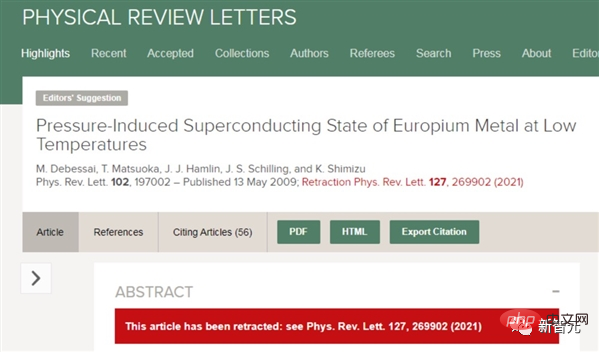
## Dias responded that Hirsch was not a high-pressure physicist and that his criticism was strongly biased.
In fact, Hirsch has made great contributions to quantum many-body research. He perfected the Monte Carlo algorithm for fermion determinants, and has been studying various High-voltage superconductivity experiments and BCS theory.
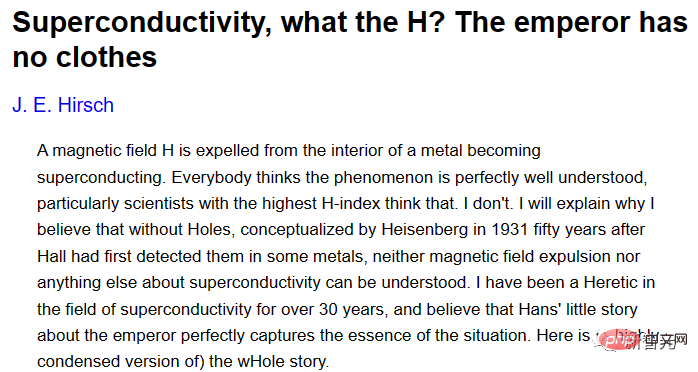
Hirsch bluntly stated that there are "loopholes" in the BCS superconducting theory, and a large number of scholars are pouring water into this field
Several subsequent papers published by Hirsch criticizing Dias were deleted, and arXiv even banned them for 6 months. Does this mean victory for Dias?
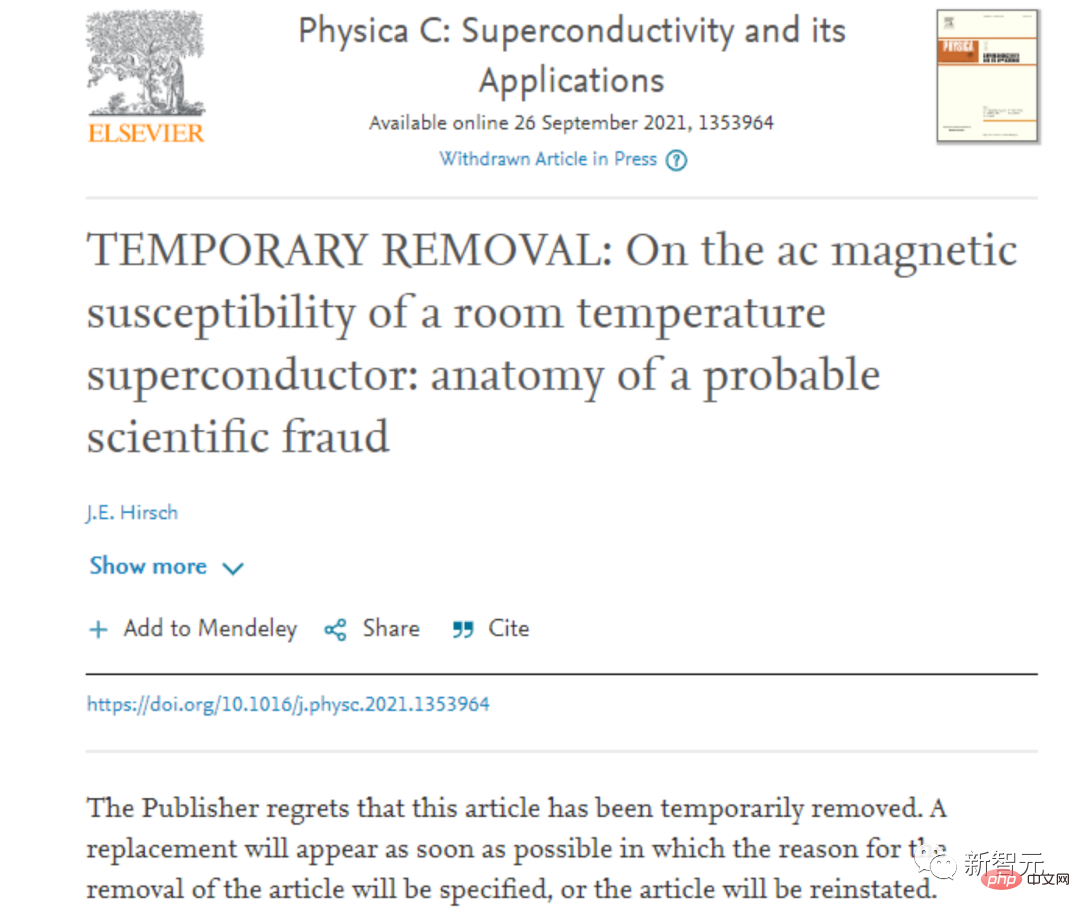
##Hirsch’s questioning article was deleted by Physica C
it's not true!
In 2022, doubts reached a climax with the retraction of the paper. On September 26, Nature editors forced the removal of the cover article despite the collective opposition of the authors.
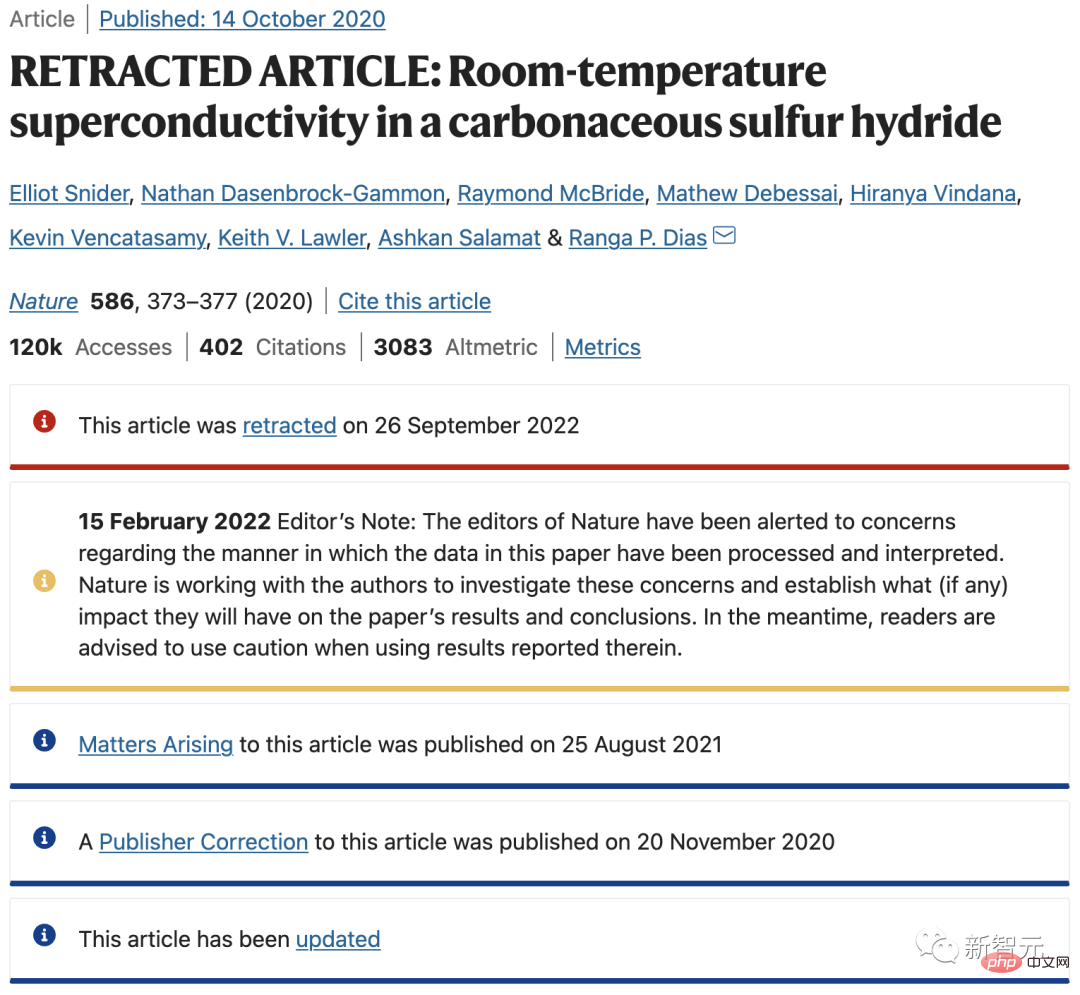

## On the day the article was withdrawn, the Science News column The incident was reported as having "serious problems" with the study.
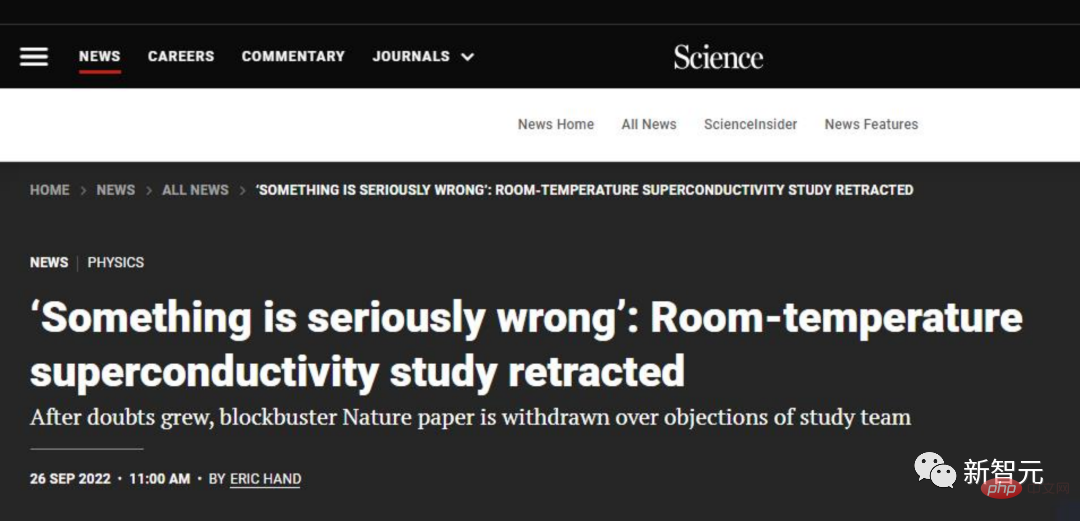
The reason given in the retraction notice responded to previous doubts, stating that the Dias team "used a non-standard , a custom program" to remove noise from the experimental data shown in the two figures, and this method does not give a clear and reliable explanation.

Critics are happy to see the result of the retraction. Hirsch even feels that this is not enough. The real problem of academic fraud has not been dealt with.
The Dias team is obviously not convinced. Team member Ashkan Salamat, a physicist at the University of Nevada, Dallas, expressed confusion and disappointment with Nature’s decision because of the results of the decrease in resistance during the study. Not at the center of the controversy that is the most important part of any discovery in the field of superconductivity.
Last month they also published a new article on arXiv, re-measurement of the questioned data. However, the temperature and pressure conditions for the emergence of superconductivity this time are 133Gpa and 260K, which are different from the 267Gpa and 288K mentioned in previous studies.
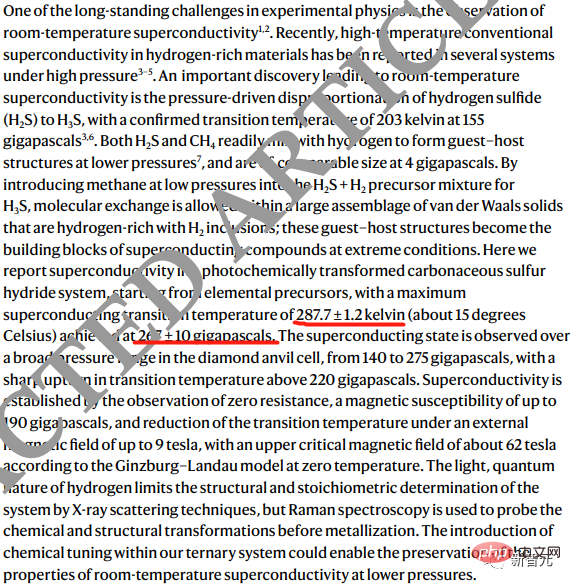

#What’s interesting is that this APS March Meeting arranged Jorge Hirsch and Ranga P. Dias in the same venue. They gave a report on both sides. The image of Hirsch in a bandage seemed to be a matter of life and death.
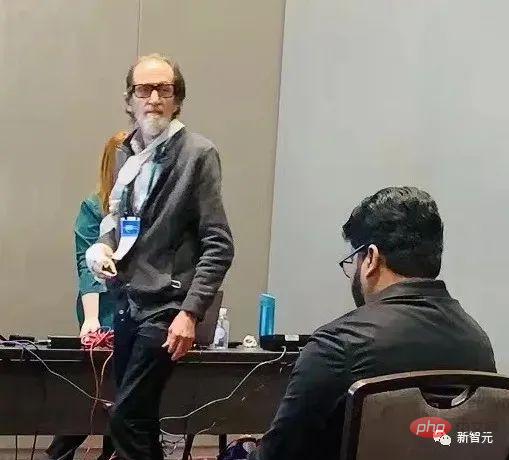
However, if the experimental results are true, it will be the biggest global scientific breakthrough this year, and Dias can also Book the Nobel Prize in advance.
The energy model of mankind will also be changed forever.
In 1900, the British physicist Baron Kelvin said that the building of physics had been completed, and all that was left was some cosmetic work. The first dark cloud is the wave theory of light, and the second dark cloud is the Maxwell-Boltzmann theory of energy equalization.
There is also a saying that whoever can develop room temperature superconductivity will be the third person in physics after Newton and Einstein.
Will Dias take off this crown and solve the third dark cloud of physics? Let us wait and see what happens next.
The above is the detailed content of AI blows up physics! Is 21-degree room temperature superconductivity scheduled for the Nobel Prize? Professor Nature withdraws his manuscript but receives investment from OpenAI. For more information, please follow other related articles on the PHP Chinese website!

Hot AI Tools

Undresser.AI Undress
AI-powered app for creating realistic nude photos

AI Clothes Remover
Online AI tool for removing clothes from photos.

Undress AI Tool
Undress images for free

Clothoff.io
AI clothes remover

AI Hentai Generator
Generate AI Hentai for free.

Hot Article

Hot Tools

Notepad++7.3.1
Easy-to-use and free code editor

SublimeText3 Chinese version
Chinese version, very easy to use

Zend Studio 13.0.1
Powerful PHP integrated development environment

Dreamweaver CS6
Visual web development tools

SublimeText3 Mac version
God-level code editing software (SublimeText3)

Hot Topics
 1379
1379
 52
52
 Debian mail server firewall configuration tips
Apr 13, 2025 am 11:42 AM
Debian mail server firewall configuration tips
Apr 13, 2025 am 11:42 AM
Configuring a Debian mail server's firewall is an important step in ensuring server security. The following are several commonly used firewall configuration methods, including the use of iptables and firewalld. Use iptables to configure firewall to install iptables (if not already installed): sudoapt-getupdatesudoapt-getinstalliptablesView current iptables rules: sudoiptables-L configuration
 How debian readdir integrates with other tools
Apr 13, 2025 am 09:42 AM
How debian readdir integrates with other tools
Apr 13, 2025 am 09:42 AM
The readdir function in the Debian system is a system call used to read directory contents and is often used in C programming. This article will explain how to integrate readdir with other tools to enhance its functionality. Method 1: Combining C language program and pipeline First, write a C program to call the readdir function and output the result: #include#include#include#includeintmain(intargc,char*argv[]){DIR*dir;structdirent*entry;if(argc!=2){
 How to set the Debian Apache log level
Apr 13, 2025 am 08:33 AM
How to set the Debian Apache log level
Apr 13, 2025 am 08:33 AM
This article describes how to adjust the logging level of the ApacheWeb server in the Debian system. By modifying the configuration file, you can control the verbose level of log information recorded by Apache. Method 1: Modify the main configuration file to locate the configuration file: The configuration file of Apache2.x is usually located in the /etc/apache2/ directory. The file name may be apache2.conf or httpd.conf, depending on your installation method. Edit configuration file: Open configuration file with root permissions using a text editor (such as nano): sudonano/etc/apache2/apache2.conf
 How to optimize the performance of debian readdir
Apr 13, 2025 am 08:48 AM
How to optimize the performance of debian readdir
Apr 13, 2025 am 08:48 AM
In Debian systems, readdir system calls are used to read directory contents. If its performance is not good, try the following optimization strategy: Simplify the number of directory files: Split large directories into multiple small directories as much as possible, reducing the number of items processed per readdir call. Enable directory content caching: build a cache mechanism, update the cache regularly or when directory content changes, and reduce frequent calls to readdir. Memory caches (such as Memcached or Redis) or local caches (such as files or databases) can be considered. Adopt efficient data structure: If you implement directory traversal by yourself, select more efficient data structures (such as hash tables instead of linear search) to store and access directory information
 Debian mail server SSL certificate installation method
Apr 13, 2025 am 11:39 AM
Debian mail server SSL certificate installation method
Apr 13, 2025 am 11:39 AM
The steps to install an SSL certificate on the Debian mail server are as follows: 1. Install the OpenSSL toolkit First, make sure that the OpenSSL toolkit is already installed on your system. If not installed, you can use the following command to install: sudoapt-getupdatesudoapt-getinstallopenssl2. Generate private key and certificate request Next, use OpenSSL to generate a 2048-bit RSA private key and a certificate request (CSR): openss
 How to implement file sorting by debian readdir
Apr 13, 2025 am 09:06 AM
How to implement file sorting by debian readdir
Apr 13, 2025 am 09:06 AM
In Debian systems, the readdir function is used to read directory contents, but the order in which it returns is not predefined. To sort files in a directory, you need to read all files first, and then sort them using the qsort function. The following code demonstrates how to sort directory files using readdir and qsort in Debian system: #include#include#include#include#include//Custom comparison function, used for qsortintcompare(constvoid*a,constvoid*b){returnstrcmp(*(
 How to perform digital signature verification with Debian OpenSSL
Apr 13, 2025 am 11:09 AM
How to perform digital signature verification with Debian OpenSSL
Apr 13, 2025 am 11:09 AM
Using OpenSSL for digital signature verification on Debian systems, you can follow these steps: Preparation to install OpenSSL: Make sure your Debian system has OpenSSL installed. If not installed, you can use the following command to install it: sudoaptupdatesudoaptininstallopenssl to obtain the public key: digital signature verification requires the signer's public key. Typically, the public key will be provided in the form of a file, such as public_key.pe
 How Debian OpenSSL prevents man-in-the-middle attacks
Apr 13, 2025 am 10:30 AM
How Debian OpenSSL prevents man-in-the-middle attacks
Apr 13, 2025 am 10:30 AM
In Debian systems, OpenSSL is an important library for encryption, decryption and certificate management. To prevent a man-in-the-middle attack (MITM), the following measures can be taken: Use HTTPS: Ensure that all network requests use the HTTPS protocol instead of HTTP. HTTPS uses TLS (Transport Layer Security Protocol) to encrypt communication data to ensure that the data is not stolen or tampered during transmission. Verify server certificate: Manually verify the server certificate on the client to ensure it is trustworthy. The server can be manually verified through the delegate method of URLSession



